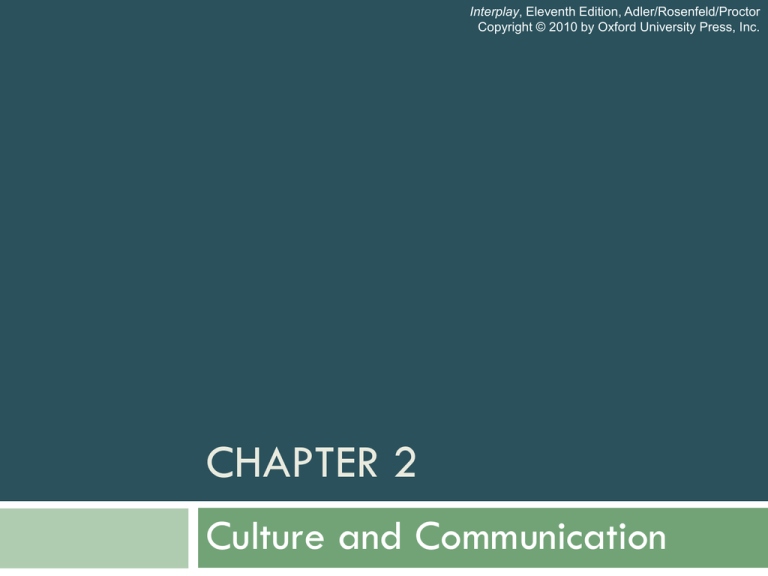Interplay Ch. 2 - Forensicconsultation.org
advertisement

Interplay, Eleventh Edition, Adler/Rosenfeld/Proctor Copyright © 2010 by Oxford University Press, Inc. CHAPTER 2 Culture and Communication Interplay Section 1 FUNDAMENTAL CONCEPTS Interplay, Eleventh Edition, Adler/Rosenfeld/Proctor Copyright © 2010 by Oxford University Press, Inc. The Global Village Marshall McLuhan: “Global village” “Members of every nation are connected by communication technology.” Interplay, Eleventh Edition, Adler/Rosenfeld/Proctor Copyright © 2010 by Oxford University Press, Inc. Culture and Intercultural Communication Culture, defined: 500 possibilities Working definition: “The language, values, beliefs, traditions, and customs people share and learn.” Bound by perception and definition. Interplay, Eleventh Edition, Adler/Rosenfeld/Proctor Copyright © 2010 by Oxford University Press, Inc. Fundamental Concepts In-groups Out-groups Social identity Co-culture Interplay, Eleventh Edition, Adler/Rosenfeld/Proctor Copyright © 2010 by Oxford University Press, Inc. Intercultural Communication Intercultural communication, defined: “The process that occurs when two or more cultures or cocultures exchange messages in a manner that is influenced by their different cultural perceptions and symbol systems, both verbal and nonverbal (Samovar, et. al., 2007)” Interplay, Eleventh Edition, Adler/Rosenfeld/Proctor Copyright © 2010 by Oxford University Press, Inc. Degrees of Cultural Significance Encounters fit along a spectrum of “interculturalness” Least intercultural: Cultural differences mean little Most intercultural: Differences, backgrounds, beliefs noteworthy “Salience”: The weight we attach to a particular person or phenomenon. Interplay, Eleventh Edition, Adler/Rosenfeld/Proctor Copyright © 2010 by Oxford University Press, Inc. Interpersonal Communication and Intercultural Communication Research: “Forms a 2x2 matrix in which the importance of interpersonal communication forms one dimension and intercultural significance forms the second one.” Interplay, Eleventh Edition, Adler/Rosenfeld/Proctor Copyright © 2010 by Oxford University Press, Inc. Example of 2x2 Matrix Interplay, Eleventh Edition, Adler/Rosenfeld/Proctor Copyright © 2010 by Oxford University Press, Inc. Cultural Differences as Generalizations Cultural practices aren’t totally different. Common ground Greater differences within cultures than between cultures. Generalizations don’t always apply. Interplay, Eleventh Edition, Adler/Rosenfeld/Proctor Copyright © 2010 by Oxford University Press, Inc. Interplay Section 2 CULTURAL VALUES AND NORMS Interplay, Eleventh Edition, Adler/Rosenfeld/Proctor Copyright © 2010 by Oxford University Press, Inc. High- Versus Low-Context Anthropologist Edward T. Hall: Low-context culture Language expresses thoughts, feelings, and ideas as directly as possible. High-context culture Relies heavily on subtle, often nonverbal cues to maintain social harmony How do these cultural norms impact communication? How do individuals in a lowcontext culture communicate differently from high context cultures? Interplay, Eleventh Edition, Adler/Rosenfeld/Proctor Copyright © 2010 by Oxford University Press, Inc. Individualism Versus Collectivism Individualistic: Primary responsibility to help oneself. Collectivistic: Loyalties and obligations to the in-group, extended, family, community, or work organization. Interplay, Eleventh Edition, Adler/Rosenfeld/Proctor Copyright © 2010 by Oxford University Press, Inc. Power Distance Power distance, defined: Degree to which members of a society accept an unequal distribution of power. How is power distance identified in different cultures? How does power distance impact personal relationships in low- or high-context cultures? Interplay, Eleventh Edition, Adler/Rosenfeld/Proctor Copyright © 2010 by Oxford University Press, Inc. Uncertainty Avoidance Uncertainty avoidance, defined: The degree to which member of a culture feel threatened by ambiguous situations and how much they try to avoid them. How is communication affected in culture with high uncertainty avoidance? Interplay, Eleventh Edition, Adler/Rosenfeld/Proctor Copyright © 2010 by Oxford University Press, Inc. Achievement Versus Nurturing Achievement culture: Nurturing culture Societies that place a high value on material success and focus on the task at hand “Masculine” culture Cultures that regard the support of relationships as an especially important goal. “Feminine” culture How do gender roles vary based on these cultural norms? Interplay, Eleventh Edition, Adler/Rosenfeld/Proctor Copyright © 2010 by Oxford University Press, Inc. Interplay Section 3 CODES AND CULTURE Interplay, Eleventh Edition, Adler/Rosenfeld/Proctor Copyright © 2010 by Oxford University Press, Inc. Verbal Codes Language and identity How is language related to personal identity? What are examples of dominant and minority versions within the same language (for example the English language)? Interplay, Eleventh Edition, Adler/Rosenfeld/Proctor Copyright © 2010 by Oxford University Press, Inc. Verbal Communication Styles Three important differences: Directness and indirectness Elaborateness and succinctness Formality and informality Interplay, Eleventh Edition, Adler/Rosenfeld/Proctor Copyright © 2010 by Oxford University Press, Inc. Nonverbal Codes People of all cultures convey messages through facial expression and gesture. What similarities or differences in facial expression interpretations exist between cultures? Gestures? What cultures have larger “personal space” zones? How do personal space variances create difficult communication situations? Interplay, Eleventh Edition, Adler/Rosenfeld/Proctor Copyright © 2010 by Oxford University Press, Inc. Decoding Messages Translation Attributional Variations Potential for misunderstanding is always present We form some sort of interpretation of what others’ words and actions mean. Ambiguous behavior is challenging. Patterns of thought Affected by: System of logic Individualistic versus collective cultures Interplay, Eleventh Edition, Adler/Rosenfeld/Proctor Copyright © 2010 by Oxford University Press, Inc. Interplay Section 4 DEVELOPING INTERCULTURAL COMMUNICATION COMPETENCE Interplay, Eleventh Edition, Adler/Rosenfeld/Proctor Copyright © 2010 by Oxford University Press, Inc. Developing Intercultural Communication Competence Motivation and Attitude Tolerance for ambiguity Living with uncertainty Open-mindedness Desire Beware of ethnocentrism Beware of prejudice Beware of stereotyping Knowledge and skill Mindfulness Passive observation Active strategies Use appropriate selfdisclosure Interplay, Eleventh Edition, Adler/Rosenfeld/Proctor Copyright © 2010 by Oxford University Press, Inc. Interplay END OF SECTION Interplay, Eleventh Edition, Adler/Rosenfeld/Proctor Copyright © 2010 by Oxford University Press, Inc.











